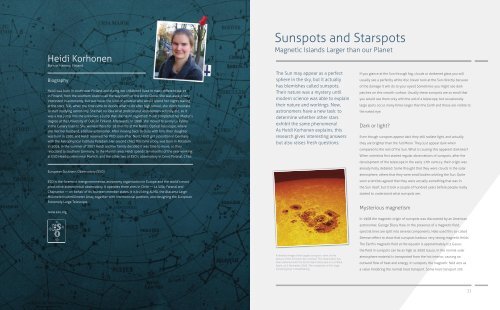Sol Lucet Omnibus - ESO
Sol Lucet Omnibus - ESO
Sol Lucet Omnibus - ESO
- TAGS
- lucet
- omnibus
- www.eso.org
Create successful ePaper yourself
Turn your PDF publications into a flip-book with our unique Google optimized e-Paper software.
Heidi Korhonen<br />
Born in Hamina, Finland<br />
Biography<br />
Heidi was born in south-east Finland and during her childhood lived in many different places<br />
in Finland, from the southern coast to all the way north of the Arctic Circle. She was always very<br />
interested in astronomy, but was never the kind of amateur who would spend her nights staring<br />
at the stars. Still, when the time came to decide what to do after high school, she didn’t hesitate<br />
to start studying astronomy. She had no idea what professional astronomers actually did, so it<br />
was a real jump into the unknown; a jump that she hasn’t regretted! Heidi completed her Master’s<br />
degree at the University of Oulu in Finland. Afterwards, in 1998, she moved to sunny La Palma<br />
in the Canary Islands. She worked there for 18 months at the Nordic Optical Telescope, where<br />
she met her husband, a fellow astronomer. After moving back to Oulu with him, their daughter<br />
was born in 2001 and Heidi received her PhD soon after. Next, Heidi got a position in Germany<br />
with the Astrophysical Institute Potsdam. Her second child, this time a boy, was born in Potsdam<br />
in 2003. In the summer of 2007 Heidi and her family decided it was time to move, so they<br />
relocated to southern Germany, to the Munich area. Heidi spends ten months of the year working<br />
at <strong>ESO</strong> Headquarters near Munich, and the other two at <strong>ESO</strong>’s observatory in Cerro Paranal, Chile.<br />
European Southern Observatory (<strong>ESO</strong>)<br />
<strong>ESO</strong> is the foremost intergovernmental astronomy organisation in Europe and the world’s most<br />
productive astronomical observatory. It operates three sites in Chile — La Silla, Paranal and<br />
Chajnantor — on behalf of its fourteen member states. It is building ALMA, the Atacama Large<br />
Millimeter/submillimeter Array, together with international partners, and designing the European<br />
Extremely Large Telescope.<br />
www.eso.org<br />
Sunspots and Starspots<br />
Magnetic Islands Larger than our Planet<br />
The Sun may appear as a perfect<br />
sphere in the sky, but it actually<br />
has blemishes called sunspots.<br />
Their nature was a mystery until<br />
modern science was able to explain<br />
their nature and workings. Now,<br />
astronomers have a new task: to<br />
determine whether other stars<br />
exhibit the same phenomena!<br />
As Heidi Korhonen explains, this<br />
research gives interesting answers<br />
but also raises fresh questions.<br />
A detailed image of the largest sunspot is seen on the<br />
picture of the full solar disc overleaf. This observation has<br />
been obtained with the Dutch Open Telescope on La Palma,<br />
Spain, on 2 November 2003. The complexity of this huge<br />
sunspot group is breathtaking.<br />
If you glance at the Sun through fog, clouds or darkened glass you will<br />
usually see a perfectly white disc (never look at the Sun directly because<br />
of the damage it will do to your eyes!) Sometimes you might see dark<br />
patches on this smooth surface. Usually these sunspots are so small that<br />
you would see them only with the aid of a telescope, but occasionally<br />
large spots occur, many times larger than the Earth and these are visible to<br />
the naked eye.<br />
Dark or light?<br />
Even though sunspots appear dark they still radiate light, and actually<br />
they are brighter than the full Moon. They just appear dark when<br />
compared to the rest of the Sun. What is causing this apparent darkness?<br />
When scientists first started regular observations of sunspots, after the<br />
development of the telescope in the early 17th century, their origin was<br />
already hotly debated. Some thought that they were clouds in the solar<br />
atmosphere, others that they were small bodies orbiting the Sun. Quite<br />
soon scientists agreed that they were actually something that was in<br />
the Sun itself, but it took a couple of hundred years before people really<br />
started to understand what sunspots are.<br />
Mysterious magnetism<br />
In 1908 the magnetic origin of sunspots was discovered by an American<br />
astronomer, George Ellery Hale. In the presence of a magnetic field,<br />
spectral lines are split into several components. Hale used this so-called<br />
Zeeman effect to show that sunspots harbour very strong magnetic fields.<br />
The Earth’s magnetic field at the equator is approximately 0.3 Gauss;<br />
the field in sunspots can be as high as 3000 Gauss. In the normal solar<br />
atmosphere material is transported from the hot interior, causing an<br />
outward flow of heat and energy. In sunspots, the magnetic field acts as<br />
a valve hindering the normal heat transport. Some heat transport still<br />
33

















